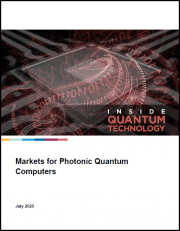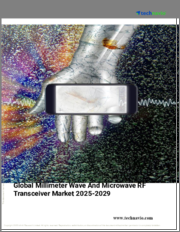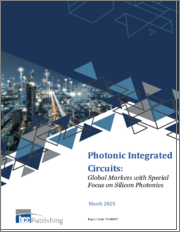
|
시장보고서
상품코드
1629024
포토닉 집적회로 시장 규모, 점유율, 성장 분석 : 집적 유형별, 컴포넌트별, 원재료별, 용도별, 지역별 - 산업 예측(2025-2032년)Photonic Integrated Circuit Market Size, Share, Growth Analysis, By Type of Integration (Hybrid, Monolithic), By Components (Lasers, Modulators), By Raw Materials, By Applications, By Region - Industry Forecast 2025-2032 |
||||||
세계의 포토닉 집적회로 시장 규모는 2023년에 136억 5,000만 달러에 달하며, 예측 기간(2025-2032년)의 CAGR은 10.7%로, 2024년 151억 1,000만 달러에서 2032년까지는 340억 8,000만 달러로 성장할 전망입니다.
세계의 포토닉 집적회로(PIC) 시장은 통신의 발전과 다양한 분야에서 포토닉스에 대한 의존도가 높아짐에 따라 크게 성장할 것으로 예상됩니다. 특히 급증하는 데이터센터, 5G 네트워크, 자율주행차량의 LiDAR와 같은 신기술로 인한 고속 데이터 전송에 대한 수요는 뛰어난 성능, 소형 사이즈, 에너지 효율성으로 유명한 PIC의 매력을 더욱 부각시키고 있습니다. 그러나 전문 지식의 필요성, 높은 초기 비용, 복잡한 설계 및 제조 공정 등의 과제는 여전히 남아있습니다. 항공우주, 헬스케어 등의 분야에서의 규제 장벽은 시장 역학을 더욱 복잡하게 만들고 있습니다. 그러나 R&D 투자 증가, 전략적 제휴, 양자 컴퓨팅 및 실리콘 포토닉스 분야의 기술 혁신은 향후 수년간 PIC 시장의 성장 기회로 작용할 것으로 보입니다.
목차
서론
- 조사의 목적
- 조사 범위
- 정의
조사 방법
- 정보 조달
- 2차 데이터와 1차 데이터 방법
- 시장 규모 예측
- 시장의 전제조건과 제한
개요
- 세계 시장 전망
- 공급과 수요 동향 분석
- 부문별 기회 분석
시장 역학과 전망
- 시장 개요
- 시장 규모
- 시장 역학
- 촉진요인과 기회
- 억제요인과 과제
- Porter의 산업 분석
주요 시장 인사이트
- 주요 성공 요인
- 경쟁의 정도
- 주요 투자 기회
- 시장 에코시스템
- 시장의 매력 지수(2024년)
- PESTEL 분석
- 거시경제 지표
- 밸류체인 분석
- 가격 분석
- 기술 분석
- 규제 분석
- 특허 분석
- 사례 연구 분석
포토닉 집적회로 시장 규모 : 집적 유형별·CAGR(2025-2032년)
- 시장 개요
- 하이브리드
- 모놀리식
- 모듈
포토닉 집적회로 시장 규모 : 컴포넌트별·CAGR(2025-2032년)
- 시장 개요
- 레이저
- 변조기
- 광검출기
- 감쇠기
- 광증폭기
포토닉 집적회로 시장 규모 : 원재료별·CAGR(2025-2032년)
- 시장 개요
- 니오브산리튬
- 실리카 온 실리콘
- Silicon-on-Insulator
- 갈륨 비소
- 인화인듐
포토닉 집적회로 시장 규모 : 용도별·CAGR(2025-2032년)
- 시장 개요
- 광섬유 통신
- 광섬유 센서
- 바이오메디컬
- 양자 컴퓨팅
- 기타
포토닉 집적회로 시장 규모·CAGR(2025-2032년)
- 북미
- 미국
- 캐나다
- 유럽
- 독일
- 스페인
- 프랑스
- 영국
- 이탈리아
- 기타 유럽 지역
- 아시아태평양
- 중국
- 인도
- 일본
- 한국
- 기타 아시아태평양
- 라틴아메리카
- 브라질
- 기타 라틴아메리카 지역
- 중동 및 아프리카
- GCC 국가
- 남아프리카공화국
- 기타 중동 및 아프리카
경쟁 정보
- 상위 5사의 비교
- 주요 기업의 시장 포지셔닝(2024년)
- 주요 시장 기업이 채택한 전략
- 시장의 최근 동향
- 기업의 시장 점유율 분석(2024년)
- 주요 기업의 기업 개요
- 회사 개요
- 제품 포트폴리오 분석
- 기업의 부문별 점유율 분석
- 매출의 전년대비 비교(2022-2024년)
주요 기업 개요
- Avago Technologies(US)
- Ciena Corporation(US)
- EMCORE Corporation(US)
- Enablence Technologies(Canada)
- Finisar Corporation(US)
- Hewlett-Packard(US)
- Infinera Corporation(US)
- Intel Corporation(US)
- JDS Uniphase Corporation(US)
- Kaiam Corporation(US)
- OneChip Photonics(Canada)
- TE Connectivity(Switzerland)
결론과 제안
KSA 25.01.20Global Photonic Integrated Circuit Market size was valued at USD 13.65 billion in 2023 and is poised to grow from USD 15.11 billion in 2024 to USD 34.08 billion by 2032, growing at a CAGR of 10.7% during the forecast period (2025-2032).
The global photonic integrated circuit (PIC) market is poised for significant growth, propelled by advancements in telecommunications and an increasing reliance on photonics across various sectors. The demand for high-speed data transmission, particularly driven by surging data centers, 5G networks, and emerging technologies like LiDAR for autonomous vehicles, underlines the appeal of PICs-known for their superior performance, compact size, and energy efficiency. However, challenges such as specialized knowledge requirements, high initial costs, and complex design and manufacturing processes persist. Regulatory hurdles in sectors like aerospace and healthcare further complicate market dynamics. Nonetheless, rising investments in R&D, strategic collaborations, and innovations in quantum computing and silicon photonics present promising opportunities for growth in the PIC market in the coming years.
Top-down and bottom-up approaches were used to estimate and validate the size of the Global Photonic Integrated Circuit market and to estimate the size of various other dependent submarkets. The research methodology used to estimate the market size includes the following details: The key players in the market were identified through secondary research, and their market shares in the respective regions were determined through primary and secondary research. This entire procedure includes the study of the annual and financial reports of the top market players and extensive interviews for key insights from industry leaders such as CEOs, VPs, directors, and marketing executives. All percentage shares split, and breakdowns were determined using secondary sources and verified through Primary sources. All possible parameters that affect the markets covered in this research study have been accounted for, viewed in extensive detail, verified through primary research, and analyzed to get the final quantitative and qualitative data.
Global Photonic Integrated Circuit Market Segmental Analysis
Global Photonic Integrated Circuit Market is segmented by Type of Integration, Components, Raw Materials, Applications and region. Based on Type of Integration, the market is segmented into Hybrid, Monolithic and Module. Based on Components, the market is segmented into Lasers, Modulators, Photo Detectors, Attenuators and Optical Amplifiers. Based on Raw Materials, the market is segmented into Lithium Niobate, Silica-on-Silicon, Silicon-on-Insulator, Gallium Arsenide and Indium Phosphide. Based on Applications, the market is segmented into Optical Fiber Communications, Optical Fiber Sensor, Biomedical, Quantum Computing and Others. Based on region, the market is segmented into North America, Europe, Asia Pacific, Latin America and Middle East & Africa.
Driver of the Global Photonic Integrated Circuit Market
A major factor propelling the growth of the global Photonic Integrated Circuit (PIC) market is the rising demand for high-speed data transmission and applications that require significant bandwidth. As digital transformation accelerates across various sectors such as telecommunications, data centers, and cloud computing, there is a heightened need for advanced optical communication technologies. Photonic Integrated Circuits provide a compact, energy-efficient, and scalable solution that efficiently manages substantial data volumes at extraordinary speeds. This makes them essential for next-generation network infrastructure, including 5G wireless communication and optical interconnects, thereby stimulating a robust demand for enhanced data rates and improved network performance in the PIC market.
Restraints in the Global Photonic Integrated Circuit Market
A notable challenge facing the global Photonic Integrated Circuit (PIC) market is the intricate and costly nature of PIC design and production. Creating PICs necessitates sophisticated fabrication methods and the integration of various optical components, demanding not only specialized expertise but also advanced equipment. Furthermore, significant initial investments are required to set up PIC manufacturing facilities while ensuring adherence to stringent quality standards, resulting in elevated production expenses and extended lead times. This complexity limits scalability and presents barriers to market expansion. Additionally, strict regulatory frameworks and intellectual property issues further impede the broader implementation of PIC technology.
Market Trends of the Global Photonic Integrated Circuit Market
The Global Photonic Integrated Circuit (PIC) market is witnessing significant growth driven by the surge in data-intensive applications and the proliferation of advanced technologies like 5G. As the demand for high-speed optical communication and enhanced data transmission capabilities escalates, PICs are becoming essential components in various sectors, including telecommunications, data centers, and consumer electronics. Their ability to integrate multiple optical functions into a single chip not only enhances performance but also reduces costs and energy consumption. This trend underscores the increasing reliance on photonics for next-generation broadband infrastructure, ultimately propelling the market forward as industries seek innovative solutions to manage vast data flow.
Table of Contents
Introduction
- Objectives of the Study
- Scope of the Report
- Definitions
Research Methodology
- Information Procurement
- Secondary & Primary Data Methods
- Market Size Estimation
- Market Assumptions & Limitations
Executive Summary
- Global Market Outlook
- Supply & Demand Trend Analysis
- Segmental Opportunity Analysis
Market Dynamics & Outlook
- Market Overview
- Market Size
- Market Dynamics
- Drivers & Opportunities
- Restraints & Challenges
- Porters Analysis
- Competitive rivalry
- Threat of substitute
- Bargaining power of buyers
- Threat of new entrants
- Bargaining power of suppliers
Key Market Insights
- Key Success Factors
- Degree of Competition
- Top Investment Pockets
- Market Ecosystem
- Market Attractiveness Index, 2024
- PESTEL Analysis
- Macro-Economic Indicators
- Value Chain Analysis
- Pricing Analysis
- Technology Analysis
- Regulatory Analysis
- Patent Analysis
- Case Study Analysis
Global Photonic Integrated Circuit Market Size by Type of Integration & CAGR (2025-2032)
- Market Overview
- Hybrid
- Monolithic
- Module
Global Photonic Integrated Circuit Market Size by Components & CAGR (2025-2032)
- Market Overview
- Lasers
- Modulators
- Photo Detectors
- Attenuators
- Optical Amplifiers
Global Photonic Integrated Circuit Market Size by Raw Materials & CAGR (2025-2032)
- Market Overview
- Lithium Niobate
- Silica-on-Silicon
- Silicon-on-Insulator
- Gallium Arsenide
- Indium Phosphide
Global Photonic Integrated Circuit Market Size by Applications & CAGR (2025-2032)
- Market Overview
- Optical Fiber Communications
- Optical Fiber Sensor
- Biomedical
- Quantum Computing
- Others
Global Photonic Integrated Circuit Market Size & CAGR (2025-2032)
- North America (Type of Integration, Components, Raw Materials, Applications)
- US
- Canada
- Europe (Type of Integration, Components, Raw Materials, Applications)
- Germany
- Spain
- France
- UK
- Italy
- Rest of Europe
- Asia Pacific (Type of Integration, Components, Raw Materials, Applications)
- China
- India
- Japan
- South Korea
- Rest of Asia-Pacific
- Latin America (Type of Integration, Components, Raw Materials, Applications)
- Brazil
- Rest of Latin America
- Middle East & Africa (Type of Integration, Components, Raw Materials, Applications)
- GCC Countries
- South Africa
- Rest of Middle East & Africa
Competitive Intelligence
- Top 5 Player Comparison
- Market Positioning of Key Players, 2024
- Strategies Adopted by Key Market Players
- Recent Developments in the Market
- Company Market Share Analysis, 2024
- Company Profiles of All Key Players
- Company Details
- Product Portfolio Analysis
- Company's Segmental Share Analysis
- Revenue Y-O-Y Comparison (2022-2024)
Key Company Profiles
- Avago Technologies (US)
- Company Overview
- Business Segment Overview
- Financial Updates
- Key Developments
- Ciena Corporation (US)
- Company Overview
- Business Segment Overview
- Financial Updates
- Key Developments
- EMCORE Corporation (US)
- Company Overview
- Business Segment Overview
- Financial Updates
- Key Developments
- Enablence Technologies (Canada)
- Company Overview
- Business Segment Overview
- Financial Updates
- Key Developments
- Finisar Corporation (US)
- Company Overview
- Business Segment Overview
- Financial Updates
- Key Developments
- Hewlett-Packard (US)
- Company Overview
- Business Segment Overview
- Financial Updates
- Key Developments
- Infinera Corporation (US)
- Company Overview
- Business Segment Overview
- Financial Updates
- Key Developments
- Intel Corporation (US)
- Company Overview
- Business Segment Overview
- Financial Updates
- Key Developments
- JDS Uniphase Corporation (US)
- Company Overview
- Business Segment Overview
- Financial Updates
- Key Developments
- Kaiam Corporation (US)
- Company Overview
- Business Segment Overview
- Financial Updates
- Key Developments
- OneChip Photonics (Canada)
- Company Overview
- Business Segment Overview
- Financial Updates
- Key Developments
- TE Connectivity (Switzerland)
- Company Overview
- Business Segment Overview
- Financial Updates
- Key Developments



















